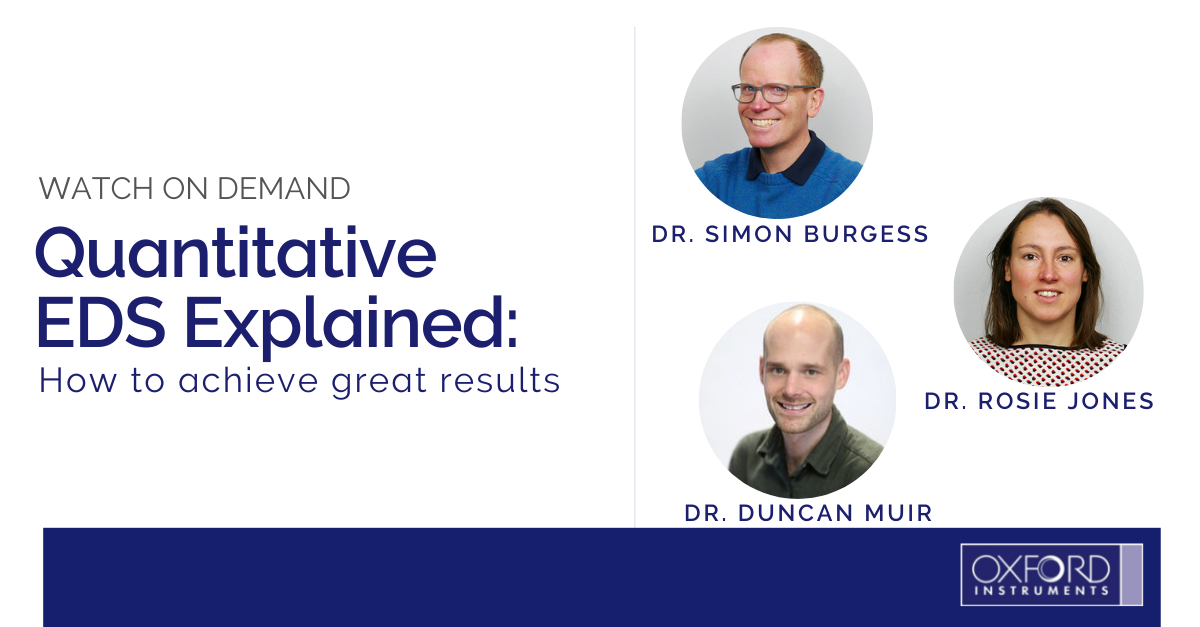19th May 2021 | Author: Dr Simon Burgess
The end of March saw Rosie and I joined by Duncan Muir from Cardiff University to present our webinar: Quantitative EDS Explained: How to achieve great results. If you missed it, you can watch it on demand now.

Thank you to all of those who tuned in. We received questions on many topics related to quantitative analysis by EDS and/or WDS, but one recurring theme was about the reluctance you see from some journals and reviewers to accept composition results measured by EDS. This was one topic we were particularly keen to tackle in our webinar and we were very happy Duncan Muir could join us to share his experience and recipe for publication success.
In his presentation Duncan showed how he uses recognised secondary standard materials to test, optimise, and prove the accuracy of the EDS results obtained on the analytical SEM in his lab. He showed how results within 2% relative of standard compositions down to quite low concentration levels can be routinely achieved. He also provides these secondary standard measurements to journals to be published as supplementary information. This can be seen in one example Duncan highlighted, in a letter to the journal Nature:
Deep roots for mid-ocean-ridge volcanoes revealed by plagioclase-hosted melt inclusions by Bennett et al., 2019, Nature volume 572, pages 235–239).
See: Supplementary Information: Supplementary tables
Another theme of questions during the webinar, was issues with using what is perceived as a ‘black box’ approach, like the AZtec software, for calculating data for publications. Whilst our main aim when creating the AZtec software was to produce a solution that was as simple as inputting the data and receiving an accurate output. This approach will of course cast doubts on data authenticity within academia. As such, a large focus of our webinar was to explain how our algorithms work.
Our algorithms are also outlined and explained in a number of papers that you can reference (see below), They were also summarised in the paper mentioned in my last post by Philippe Pinard et al: ‘Development and validation of standardless and standards-based X-ray microanalysis’.
In this publication you will also find references to particular parts of our spectrum processing and quantification software algorithms and Tru-Q® technology, for example:
- Spectrum processing and filtered least squares fitting: Statham P J (1977) Anal. Chem. 49 2149-2154
- Peak Profiles: Statham (2014) Microsc. Microanal. 20 690-691 and Statham et al. (2016) IOP Conf. Ser.: Mater. Sci. Engng. 109 12016
- Detector Efficiency: Statham (2009) Microsc. Microanal. 15 528-529 and Statham (2010) Microsc. Microanal. 16 1304-1305
- Pulse Pile-up Correction: Statham P J (2006) Microchim. Acta 155 289-294
- XPP Matrix Correction: Pouchou J-L and Pouchou F (1991) Quantitative analysis of homogeneous or stratified microvolumes applying the model “PAP”. in: Electron probe quantitation. (Heinrich K F J and Newbury D E; Eds.) (New York, NY: Plenum Press) 31-75
Therefore, do not think of AZtec as a ‘black box’, rather powered by a highly developed spectrum processing and analysis engine which is explained, validated, and referenced in numerous publications. As Duncan showed, EDS data collected and processed in AZtec has been published in the highest impact scientific journals, when supported by secondary standard measurements, which prove the accuracy of the technique, the algorithms, and the analyst’s experimental methods.
If you have any further questions about quantitative analysis, publishing data, or any other issues covered in the webinar or my blog posts, you are welcome to leave questions in the comment section below.
Ask Simon a question


